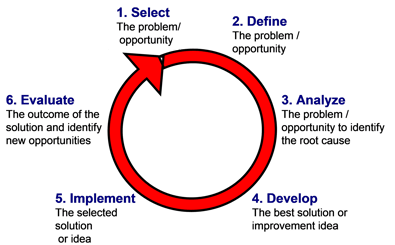Training for Problem Solving and Decision Making Skills
As a manager, you deal with problems every day. You use your past experience, the information at hand and your team’s expertise to identify and implement a solution. “See it; fix it; move on” is often the common, immediate response.
Occasionally though, it is important to take a longer-term view to problem solving. High achiever managers recognize that some problems require a more methodical, inclusive process in order to get to the root of the problem, not just apply a band-aid. Download a FREE Fishbone Template Below!
Do you want your teams to get better? Problem solving skills is a solution. We have courses designed to provide you with the theory, tools and techniques to hone and refine individual’s problem solving and decision-making abilities.
Seek Causes vs. Symptoms
A key message that will be reinforced in this course is to ‘dig deep’ and ‘get beyond dealing with symptoms’. You have probably heard it all before. Maybe you have even experienced it as well.
Deal with Causes not with Symptoms.
The metaphor of a Doctor visit is a perfect analogy. If you treat each of your symptoms separately, you are going to end up being stuck in an endless loop of recurring problems and short-term band-aid solutions. You may or may not get well.
Your role as a Manager is to see the bigger picture and to put together all the symptoms of problems that you are seeing in your operation. The discipline and approach you take as a Problem Solver will have a significant effect on the results for both you and your entire team. A good leadership development program is always worth your investment of time.
Slow Down to Speed Up
We have all heard the saying “Take 1-step forward and 2-steps back”. Sometimes you need to slow down, before you can speed up.
Slowing down, even just a little never seems to be an option in business. But to elevate your game to the level of master problem solver, a big challenge you are going to face is “slowing down” to solve a problem. You need time to get your facts straight - to think things through. Jumping to conclusions and knee-jerk reactions are most likely to lead you down the path of band-aid solutions and more frustration.
Slowing down to solve a problem doesn’t have to be a futile exercise. Defining the problem up front and being really clear about what it’s costing your operation is going to get people’s attention. It’s also likely to get you the time and resources you need to get to the root cause and deal with the problem once and for all.
Be a great Problem “Definer” before being a great Solution Provider
Have you ever seen “Superb problem definition expertise” on someone’s resume? The fact is that we see ourselves as successful when we come up with great solutions. The emphasis in business is on the winning idea that makes the problem go away. You never hear about all the grunt work that goes into defining the problem and really taking the time to understand what exactly you are dealing with.
So naturally, what happens is that we put most of our focus and energy on the solution ideas. It makes perfect sense. Why wouldn’t we? After all, coming up with great ideas to solve problems is what gets us respect and credibility.
“It isn’t that they can’t see the solution. It is that they can’t see the problem.”
G. K. Chesterton
Ask yourself:
Consider the last problem you solved as part of a group?
Was the group successful? If yes, why? If no, why not?
Problem Solving Overview
The generally accepted definition of Problem Solving is as follows:
Problem Solving is the process of finding the best applicable solution
to a problem or identifying an innovative solution
to an improvement opportunity.
The Six-Step Problem Solving Process:
On paper, the Problem Solving process may seem a little underwhelming to you. The steps are probably a natural part of your well-trained instincts. But the magic is not in the words used to describe the process. The magic is in the discipline that it takes to follow the process, know when and how to apply the tools, and deliver results.
The value of having a consistent process that you can reference also pays off in some unexpected ways. The six-step problem solving process gives us a common language that we can use to define and analyze problems. It also gives you a foundation in your teams to synchronize, calibrate and focus your problem solving activities.
Problem Solving Methods as a Core Skill
No matter where you are within the business, problem solving skills and methods are core skills. Problem solving training can help you develop your skills.
Problem Solving Uses Your Whole Brain
The left and right side of your brain are used more actively for different kinds of tasks. The two sides of our brains specialize as follows:
LEFT = Logical (speech, arithmetic, writing, structure)
RIGHT = Creative (art, music, symbols, spatial relationships)
A common myth is that problem solving is all about logic.
Think back to the best solution you ever came up with. Was it based on a crazy idea that may have seemed impossible at first? That can be a typical experience for most of us. Where did that idea come from? Most likely, it came from your imagination or maybe from a brainstorming session with your team.
‘Problem Solvers’ need to be able to think logically and creatively; to be strong throughout the entire problem solving process.
Too much logic and you could be limiting the potential for a deeper understanding of the problem or a really innovative solution. Logic is always balanced by the creativity it takes to see all of the potential causes of the problem and come up with a range of solutions.
Effective problem solving is a balancing act between a logical, rational approach and the creative ideas that drive innovation.
For yourself and for your teams, remember to encourage both logical and creative thinking styles throughout the problem solving process.
When you have recognized that some problems require a more thorough process in order to get to the root of the problem the fish bone exercise can be a valuable tool. Not only does this help manage the stress of dealing with problems, it also provides you with a clear breakdown of what is the root cause of your problem.
Below is an example of how this download can be used, and we are also giving you a fillable copy for your use for FREE! Happy Problem Solving.
Download this free downloadable template:




%20DIAGRAM%20TEMPLATE%20%20Final%20Rectangle%20%20V2%20Small.jpg?width=458&name=FISHBONE(%20CAUSE%20%26%20EFFECT%20)%20DIAGRAM%20TEMPLATE%20%20Final%20Rectangle%20%20V2%20Small.jpg)